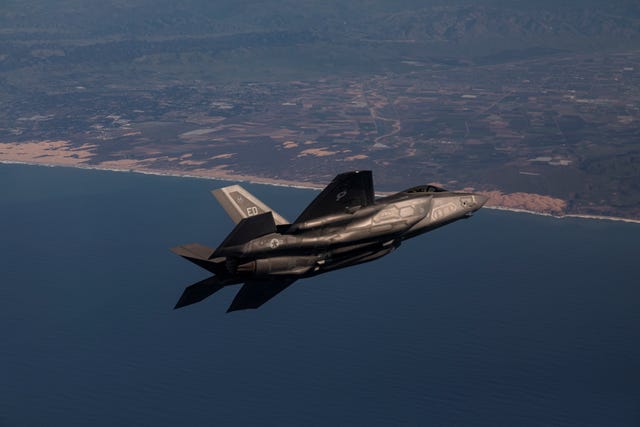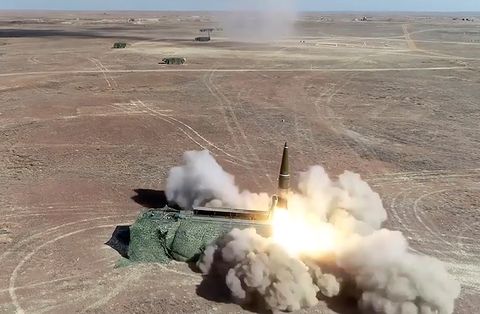
Why the Pentagon Is Equipping the F-35 With a Thermonuclear Bomb
A man with a bomb can do things a missile with a bomb can’t.
By Kyle MizokamiNov 5, 2021
- The F-35 Joint Strike Fighter is nearly certified to carry a new thermonuclear weapon, the B61-12.
- Although the U.S. military has a variety of ways to deliver nuclear weapons, there are only a handful of ways to use them on the battlefield.
- Using a crewed delivery system ensures there is a person in the loop for the entire flight who can execute last minute instructions.
The Air Force has completed the flight testing to ensure the F-35A can safely—and reliably—drop the B61-12 thermonuclear bomb. The combination of crewed aircraft and nuclear bomb will ensure the U.S. government would have options in the event of a crisis, including one where a nuclear bomb could be literally recalled at the last second.
Nuclear weapons are divided into two categories: strategic and tactical. The two main differences between the two types are explosive yield and range. Tactical nuclear weapons typically range from about .3 kilotons (300 tons of TNT) to about 50 kilotons (50,000 tons of TNT).
Strategic nuclear weapons are in an entirely different class altogether. The yield of strategic nukes can range from 100 kilotons to well into the megaton range, with the U.S. military’s largest weapon having a yield of 1.3 megatons (the equivalent of 1,200,000 tons of TNT). Tactical nuclear weapons are generally shorter range weapons with ranges of 500 miles or less, while strategic nuclear weapons are designed to cross entire oceans to strike targets on the other side of the planet.
Today, tactical nuclear weapons are delivered by aircraft and submarine-launched missiles. The most numerous U.S. tactical nuclear weapon is the B61 series of bombs, a series that has been in continuous use since the 1960s. In the 2010s, the U.S. military developed a new B61 bomb, the B61-12. The B61-12 is not only more accurate, it’s designed to penetrate earth and concrete to strike underground facilities—think North Korean underground leadership bunkers, Iranian nuclear facilities, or similar targets.
This penetrating capability allows it to be more effective at nuking underground threats with less explosive power. The B61-12, rebuilt from older B61 series bombs, has a smaller yield and in fact has a “dial-a-yield” mechanism that allows for the yield to vary from .3 kiltons, 1.5 kilotons, 10 kilotons, and 50 kilotons.
One of the most important principles behind nuclear weapons is the idea of maintaining positive control over them at all times, as much as possible, up until the moment of detonation. This is not only a safety feature, it allows decision-makers increased flexibility under incredibly stressful circumstances.
A crewed aircraft makes an ideal platform for maximum control. With a crewed delivery system, the President of the United States could order a F-35A armed with the B61-12 to strike a target, then change his or her mind if the circumstances change. If the enemy suddenly calls for peace, the strike can be called off. This “recallability” is replicated at the strategic level with bombers like the B-2 Spirit, and the F-35A/B61-12 combo offers war planners the same capability at the tactical nuclear level. The F-35A’s stealth gives it a greater chance, unlike legacy aircraft like the F-15E Strike Eagle, of successfully penetrating enemy defenses and reaching the target.
Advertisement – Continue Reading Below

A Russian Iskander-M short range nuclear-capable ballistic missile at launch, 2019. U.S. planners could use the B61-12 against Iskander M launch vehicles—or the headquarter units that would order them to fire.
What kind of targets could a F-35A drop a nuclear bomb on? Thanks to America’s overwhelming conventional firepower, it’s difficult to see the U.S. use nuclear weapons against non-nuclear targets. One target could be the location of a Russian missile command post, nuking it to sever the chain of command between Moscow and its own tactical nuclear forces. The actual missiles could be another target. If tactical nuclear weapons are already in use, a F-35A could dial the yield down to 1.5 kilotons and strike conventional targets, such as headquarters units, supply depots, and marshalling points for conventional forces.
The F-35A/B61-12 combo will be a tactical nuclear system primarily used against military targets. Still, “a nuke is a nuke,” and the use of tactical nuclear weapons would shift any conflict into a terrifying new phase. The use of tactical nukes could very well kick off a chain of escalation that grows to include the use of strategic nuclear weapons—with civilians and human civilization itself in the crosshairs. Kyle Miz
No comments:
Post a Comment